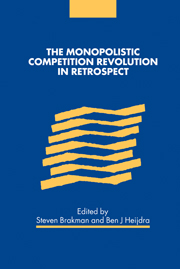Book contents
- Frontmatter
- Contents
- List of contributors
- Preface
- 1 Introduction
- Part I Underground classics
- Part II Current Perspectives
- 5 Some reflections on theories and applications of monopolistic competition
- 6 Reflections on the state of the theory of monopolistic competition
- 7 Dixit–Stiglitz, trade and growth
- Part III International trade
- Part IV Economic geography
- Part V Economic growth
- Part VI Macroeconomics
- Index
5 - Some reflections on theories and applications of monopolistic competition
Published online by Cambridge University Press: 22 September 2009
- Frontmatter
- Contents
- List of contributors
- Preface
- 1 Introduction
- Part I Underground classics
- Part II Current Perspectives
- 5 Some reflections on theories and applications of monopolistic competition
- 6 Reflections on the state of the theory of monopolistic competition
- 7 Dixit–Stiglitz, trade and growth
- Part III International trade
- Part IV Economic geography
- Part V Economic growth
- Part VI Macroeconomics
- Index
Summary
Introduction
Models of monopolistic competition are now well established as standard tools for the analysis of many economic issues. This is a relatively recent development. If we count the number of times the phrase ‘monopolistic competition’ appears in the entries (consisting of titles, and abstracts since 1989) for articles in the database Econ-Lit for the entire timespan it covers, we find the situation in table 5.1.
The rapid and continued increase in the numbers is impressive. Another fact is also noteworthy. During the 1990s, when abstracts have been available, the total number of appearances increased even while the number of appearances in titles fell. This suggests that this approach is becoming well established; users of the framework feel increasingly more assured about using it as a normal part of their toolkit without having to make a big deal about it.
This is noteworthy because the starting date of 1969 for this data was immediately after George Stigler published his important book, The Organization of Industry, which included a chapter on monopolistic competition. Reviewing the work of Robinson and Chamberlin through the lens of Triffin's general equilibrium formulation, Stigler reached a basically negative conclusion about the theory. Triffin had argued that in principle all products in a general equilibrium system formed a continuum with degrees of greater or smaller substitution. Abstract principles did not tell us where to break this chain in order to define a group or an industry.
- Type
- Chapter
- Information
- The Monopolistic Competition Revolution in Retrospect , pp. 123 - 133Publisher: Cambridge University PressPrint publication year: 2001
- 4
- Cited by

